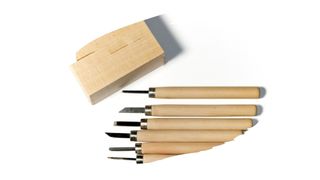When it comes to model making, not all types of glue are equally suitable for scratch building.
Some glues are water soluble (and can be easily removed). While some are much more durable – and only a searing solvent can cut through their bond.
But, when it comes to model making, using a fast-drying glue is key. So do you choose PVA glue? Maybe a super glue will bond better? Or vice versa?
Well, in this post, you’ll discover why you should skip over using wood glue for model making. You will also learn the difference between PVA and Super Glue…and why it matters for basswood models.

This post may contain affiliate links to products that we receive a commission for (at no additional cost to you). Learn more here.
Does Wood Glue Work On Basswood?
Absolutely. Basswood is a natural hardwood timber. And any standard wood glue will work fine at binding basswood sheets together.
But, when it comes to building lightweight models, wood glues may not be suitable. That’s because there’s a few problems with using wood glue for model making:
Problem 1). Wood Glues Are Only Good At Gluing Wood
If your model plans require that you glue wood to plastic, then wood glue isn’t going to be strong enough to hold.
That’s because wood glues are PVA (Polyvinyl Acetate) adhesives, meaning they are great at getting paper and wood to stick. But, they aren’t the strongest adhesive on the market, as they aren’t able to bind plastics and metals.
In other words, if you want to glue basswood to basswood, wood glue will work great. Otherwise, it won’t be enough to stick wood to plastic.
Problem 2). Wood Glues Add Weight
A quality wood glue joint needs to bind tightly if it is to hold up under pressure. And a great wood glue binds above and below the surface, leaving no gaps.
That’s why wood glues tend to sink into wood grain. This allows the adhesive to bind two pieces of lumber by their wood fiber.
However, this also means that thick wood glue products can add a fair amount of weight to a model structure.
Related Post: How To Cut Basswood Strips Down To Size
Problem 3). Wood Glues Take A While To Dry And Cure
PVA wood glues can take around 30 minutes to dry enough to hold wood in place. But, that glue isn’t properly set until it has cured. In which case, PVA glue can take up to 24 hours to cure.
If you can clamp basswood in place, (while you wait for the adhesive to dry), this shouldn’t pose a problem. But, basswood models are simply too delicate to risk using clamps on them.
And that means you’re left having to hold things in place by hand…which is both time consuming and frustrating.
OK, Then. What Glue Should I Use For Basswood Models?
Well, you can solve problems 1 and 2 by using CA (Cyanoacrylates) glue.
CA glue (also known as super glue) can glue wood, plastic, and even metal. That is because cyanoacrylate is an extremely high strength bonding ingredient.
So, that’s problem 1 solved.
Also, CA glues dry in a fraction of the time of PVA glue — thanks to its fast-drying additives. CA glue can dry in as little as 10 seconds (depending on the brand). And it can take as few as 8 hours to cure and set.
And that sorts out problem number 3.
Aren’t CA Glue And PVA Glue One And The Same? PVA wood glues are a thermoplastic adhesive. But, CA glues are made out of formaldehyde condensation. So, they are two very different kinds of substances.
If CA Glue Dries So Much Faster, Why Not Use It On All Wood Joints?
When it comes to full-size wood joints, a wood glue needs to be made of stronger stuff than even wood itself. If you use a weak adhesive to glue a wood joint, all you’ve done is create a weak joint.
Still, the big downside to CA glues, is that over time they can become brittle.
Basically, CA glue can bond two different materials quickly. But, if you put enough force/pressure on that CA glue bond, it can snap in too.
Yet, this isn’t a big issue with model making. That’s because, once complete, these lightweight architectural pieces aren’t going to be handled often.
However, if you were making a chair or table using CA glue, overtime that table/chair is likely to topple over.
On the other hand, a PVA wood glue will hold firm, even whilst under pressure.
Related Post: Choosing A Basswood Finish (What You Need To Know)
What About Problem 3? How Do I Prevent Glue From Adding Too Much Weight?
The simplest way to minimize the impact of glue weight, is to minimize the amount of glue. In other words, stick to applying thin applications of CA glue onto wood.
This not only keeps that added glue weight to a minimum, but it also makes it easier for glue to dry faster.
In addition to this, try to squeeze out as much excess glue as possible, by pressing the two glued pieces together as tight as you dare. Force the excess adhesives out the sides, and wipe it away. This also has the added benefit of making sure there are no gaps left behind.
To Wrap Up, Here Are The 3 Key Takeaways From This Post…
- 1). Wood glue, (also known as PVA glue), is strong enough to bind basswood sheets. However, it is not strong enough to bind wood to plastic and/or metal. This makes wood glue unsuitable for basswood model making.
- 2). CA glue (also referred to as super glue) is strong enough to bind wood, plastic, and metal together. It also dries much faster than PVA wood glue.
- 3). Glue can add weight to model architecture. So only apply thin applications of any adhesive, and clean away the excess.
References:
Ethyl Cyanoacrylates | Wikipedia.org


